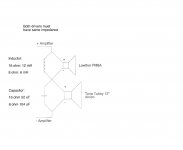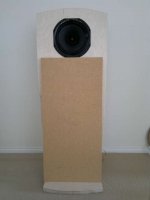I am aware of the first part of what you say, but what I am visualising is if the gain or phase of one amp is slightly different than the other amp then they will be fighting each other to drive the cone differently. At least that is what I am picturing in my mind
Member
Joined 2009
Paid Member
People like their dipole front wall bounce, most don't like it blocked.
what kind of front wall bounce is enough to be liked - some drivers, like the AN15 are not dipole, their FR and dispersion will be quite different between the front and back - yet Melon confirms they sound very nice in OB. So is it enough to have some 'reasonable' amount of front wall bounce to get the listening pleasure it confers ?
I think it is something you have to experience for youself.
It only takes 30 minutes and about $5 in good quality double wall cardboard (.25" thick) to find out.
Or if you do it properly in Birch Ply it might take a day.
It only takes 30 minutes and about $5 in good quality double wall cardboard (.25" thick) to find out.
Or if you do it properly in Birch Ply it might take a day.
well, if we take a voice, where the mids and bass go everywhere, but the highs taper off the further behind we go................... And by less highs going to the front wall, imaging (if you are into that) may make more sense.
The speaker's dispersion (front, side, and back) and your room are huge factors.
I prefer to enclose the backside. I'd expect I'd like a huge open baffle, eventhough most would not. In my mind, the front wall bounce is a false addition to the sound that shouldn't be there. And my mind usually overrules my ears. But hey, most anything sounds better with a squeek of reverb, sounds more live even if not true to the original. Your preference, your pleasure. My way is probably not the best way for you.
Just my opinion.
Norman
The speaker's dispersion (front, side, and back) and your room are huge factors.
I prefer to enclose the backside. I'd expect I'd like a huge open baffle, eventhough most would not. In my mind, the front wall bounce is a false addition to the sound that shouldn't be there. And my mind usually overrules my ears. But hey, most anything sounds better with a squeek of reverb, sounds more live even if not true to the original. Your preference, your pleasure. My way is probably not the best way for you.
Just my opinion.
Norman
I am aware of the first part of what you say, but what I am visualising is if the gain or phase of one amp is slightly different than the other amp then they will be fighting each other to drive the cone differently. At least that is what I am picturing in my mind
Well in many applications people send the left channel to one coil and the right to another, so in that case you may actually have different material being sent to each coil. Think of it as one cone receiving information from two different sources.
If I were to record your bass on one track, and then add drums to tracks two, three and four, I would not necessarily be degrading your signal or the monitors ability to reproduce bass notes... at least in theory.
I was looking at the lowther site Tiny Alnico Open Baffle
and saw this crossover. Might be ideal for dual AN15's.
and saw this crossover. Might be ideal for dual AN15's.
Attachments
Wow, thanks alazira, I was just getting around to needing to know that exact bit of information.
Bud
Bud
Instead of implementing DSP or altering Q by adding resistance, we drove one of the two coils with a clean BASH style plate amp [Is this a voltage source Amp; meaning its has a negative feedback loop]. The 2nd coil was driven normally by our full range source amplifier [same question as above ]. The balance between the two would determine low end compensation that could be dialed-in at will.
QUOTE]
Will each amp see the output of the other as error relative to its non-inverting input and correct for it ?
Member
Joined 2009
Paid Member
yes, each amplifiers output will look like a very low impedance load to the other for any differences in voltage.
I think they use a digital EQ on those speakers, so in that regard I believe it, but certainly without the DEQ they will be struggling to get flat to 20Hz. Even Nelson uses a 20Hz bass boost with his 6x8" slot loaded open baffle
Melon Head: beware of the attendant and dreaded standing waves which Mr. Pass cured by using US Patent # 4,899,387. It is entitled: Active low frequency acoustic resonance suppressor. It was granted to Threshold Corporation; inventor Nelson Pass.
So, is there power left over to move the cone after each amp wipes out the other's output?yes, each amplifiers output will look like a very low impedance load to the other for any differences in voltage.
Member
Joined 2009
Paid Member
hold on, I was mistakenly thinking you had the outputs of the two amps connected together, in parallel. But you don't - you have them connected to independent voice coils. In that case they will only interact through the load - one amp moving its voice coil will generate an emf in the other voice coil that the other amp is connected to, but this signal will be mostly damped by the other amplifier if it has a low output impedance. Maybe some low level distortion could be injected through the -ve feedback network but to be honest with my limited experience of these things I don't see there being an issue.
Bigun: thank you for your explanation.hold on, I was mistakenly thinking you had the outputs of the two amps connected together, in parallel. But you don't - you have them connected to independent voice coils. In that case they will only interact through the load - one amp moving its voice coil will generate an emf in the other voice coil that the other amp is connected to, but this signal will be mostly damped by the other amplifier if it has a low output impedance. Maybe some low level distortion could be injected through the -ve feedback network but to be honest with my limited experience of these things I don't see there being an issue.
Melon Head: beware of the attendant and dreaded standing waves which Mr. Pass cured by using US Patent # 4,899,387. It is entitled: Active low frequency acoustic resonance suppressor. It was granted to Threshold Corporation; inventor Nelson Pass.
While I am an absolute bass freak, it is probably not in the way you imagine. I absolutely hate subwoofers, and I am not really interested in anything under 40Hz. I like the sound of real musicians in my listening room, not the sound of walls shaking. Fortunately I don't have those sought of issues.
Hopefully have it finished today.
Not how i pictured it, but cool all the same😀
I just want to experiment and learn, If I like the result then I will build a proper one with AN15 on top and use bamboo ply. I also want to try a slot loaded PHY baffle. Hopefully have the MCM woofers to play with in the next 2 weeks
I was looking at the lowther site Tiny Alnico Open Baffle
and saw this crossover. Might be ideal for dual AN15's.
It's often referred to as a first order series network. The one shown in the diagram is crossing over at about 200Hz. This approach can work exceptionally well if the drivers have sufficient extension on either side of the xo pont, and if their phase curves are close through about 3 octaves on either side. It has a significant benefit relative to the interactions with the driver impedance peaks at resonance.
I use a similar arrangement in my TimePulse Lambda series, and rather than throw away efficiency with additional components, I apply the eq digitally. It works really well.
Have a look at the Holistic Audio Timepulse Lambdas in the pix, or in my website, I'm using the Dayton PS220 in a FAST open baffle with Eminence 15a. It's a fairly narrow baffle which I find really helps preserve the imaging.
No need for bi-amping, uses a passive network and a DSP based EQ system, either on the Behringer DEQ2496 or on a Mac. The PS 220 has some very ugly colorations but once they have been surgically removed in the DSP, the result is spectacularly musical, transparent and balanced.
For those that like proof of concept, I've added a picture and a frequency response graph. Note the 1/12th octave and vertical scale resolution employed for the FR graph, it's taken outdoors at 96"
Wanna build it? You could cook up your own if you're up to the task, otherwise I can provide it in kit form.
Attachments
???? No FR graph???
Sorry, I thought I had attached the FR graph. Arrghh... can't attach an Fuzzmeasure FRD file?? I managed to do this before.... why not now?
Sorry, I thought I had attached the FR graph. Arrghh... can't attach an Fuzzmeasure FRD file?? I managed to do this before.... why not now?
- Status
- Not open for further replies.
- Home
- Loudspeakers
- Full Range
- Melon Head's State of the "DUMB" Open Baffle Design


